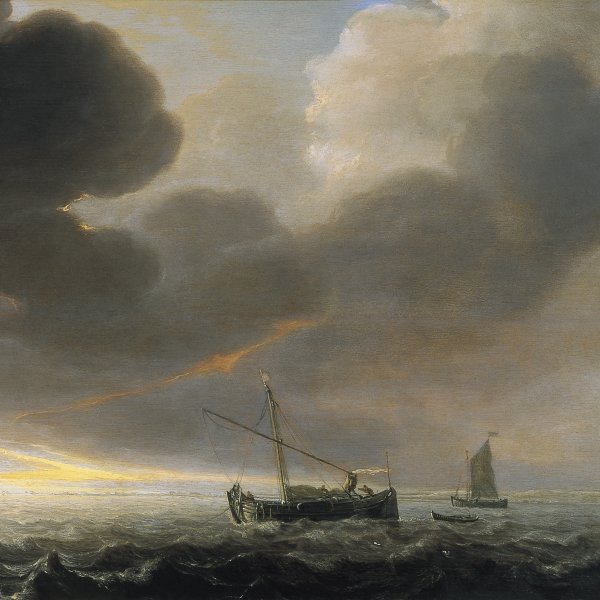Simon De Vlieger
Rotterdam, c.1601-Weesp, 1653
According to a document dated 16 May 1648, Simon Jacobsz. de Vlieger was about forty-seven years old, hence born about 1601, probably at Rotterdam. His sister Neeltje de Vlieger became a still life painter. On 10 January 1627, he married Anna Gerridts van Willige in Rotterdam, where he is also mentioned in 1628, 1630, 1632, and 1633. On 25 February 1634, he rented the house known as "Kranenburch" in Delft and on 18 October of that year became a member of the guild. On 14 December 1637, he bought a house on De Schilderstraat in Rotterdam but on 12 March 1638 was still living in Delft in the house known as "Houttuyn". On 19 July 1638, he was described in a document as an artist living in Amsterdam and probably moved to that city sometime between this date and the preceding 12 March, when he was still residing in Delft.
De Vlieger executed two designs for decorations for the festivities honouring Queen Maria de Medici's entry into Amsterdam on 31 August 1638. On 2 December 1640, and 10 March 1641, he was paid for unspecified works by the city of Delft. In 1642 he received a commission to paint organ doors for the Grote Kerk in Rotterdam, for which he was paid the considerable sum of 2, 000 guilders on 7 January 1645 (The doors, depicting King David and other figures, were destroyed in 1788). On 5 January 1643, he became a citizen of Amsterdam and on 17 September 1644 sold his house in Rotterdam. On 4 January 1648, he was commissioned to decorate the windows on the south side of the Nieuwe Kerk in Amsterdam for 6, 000 guilders. He was still living in Amsterdam on 20 November 1648, but on 13 January 1649 bought a house in Weesp. His daughter, Cornelia, was married to the Amsterdam painter Paulus van Hillegaert the Younger (1631-1658) in that city in 1651. On 2 February 1652, he was again mentioned in Rotterdam as a widower, but he died in Weesp, probably early in March 1653. His death was lamented in verses by the poet Joost van den Vondel.
A varied artist, Simon de Vlieger painted and drew seascapes, beach scenes, and landscapes, as well as a few genre scenes and portraits. His earliest dated works are of 1624. The early paintings are strongly influenced by Jan Porcellis (1584-1632) and chiefly depict ships and fantastic rocky coasts. Around 1630 he painted his first beach scenes and from 1650 onward executed mostly coastal views and marines with calmer seas and a few forest scenes. Landscapes proper form a small portion of his oeuvre. De Vlieger was also active as a printmaker. According to Houbraken, De Vlieger was the teacher of the seascapist Willem van de Velde the Younger (1633-1707).
Peter C. Sutton
De Vlieger executed two designs for decorations for the festivities honouring Queen Maria de Medici's entry into Amsterdam on 31 August 1638. On 2 December 1640, and 10 March 1641, he was paid for unspecified works by the city of Delft. In 1642 he received a commission to paint organ doors for the Grote Kerk in Rotterdam, for which he was paid the considerable sum of 2, 000 guilders on 7 January 1645 (The doors, depicting King David and other figures, were destroyed in 1788). On 5 January 1643, he became a citizen of Amsterdam and on 17 September 1644 sold his house in Rotterdam. On 4 January 1648, he was commissioned to decorate the windows on the south side of the Nieuwe Kerk in Amsterdam for 6, 000 guilders. He was still living in Amsterdam on 20 November 1648, but on 13 January 1649 bought a house in Weesp. His daughter, Cornelia, was married to the Amsterdam painter Paulus van Hillegaert the Younger (1631-1658) in that city in 1651. On 2 February 1652, he was again mentioned in Rotterdam as a widower, but he died in Weesp, probably early in March 1653. His death was lamented in verses by the poet Joost van den Vondel.
A varied artist, Simon de Vlieger painted and drew seascapes, beach scenes, and landscapes, as well as a few genre scenes and portraits. His earliest dated works are of 1624. The early paintings are strongly influenced by Jan Porcellis (1584-1632) and chiefly depict ships and fantastic rocky coasts. Around 1630 he painted his first beach scenes and from 1650 onward executed mostly coastal views and marines with calmer seas and a few forest scenes. Landscapes proper form a small portion of his oeuvre. De Vlieger was also active as a printmaker. According to Houbraken, De Vlieger was the teacher of the seascapist Willem van de Velde the Younger (1633-1707).
Peter C. Sutton




